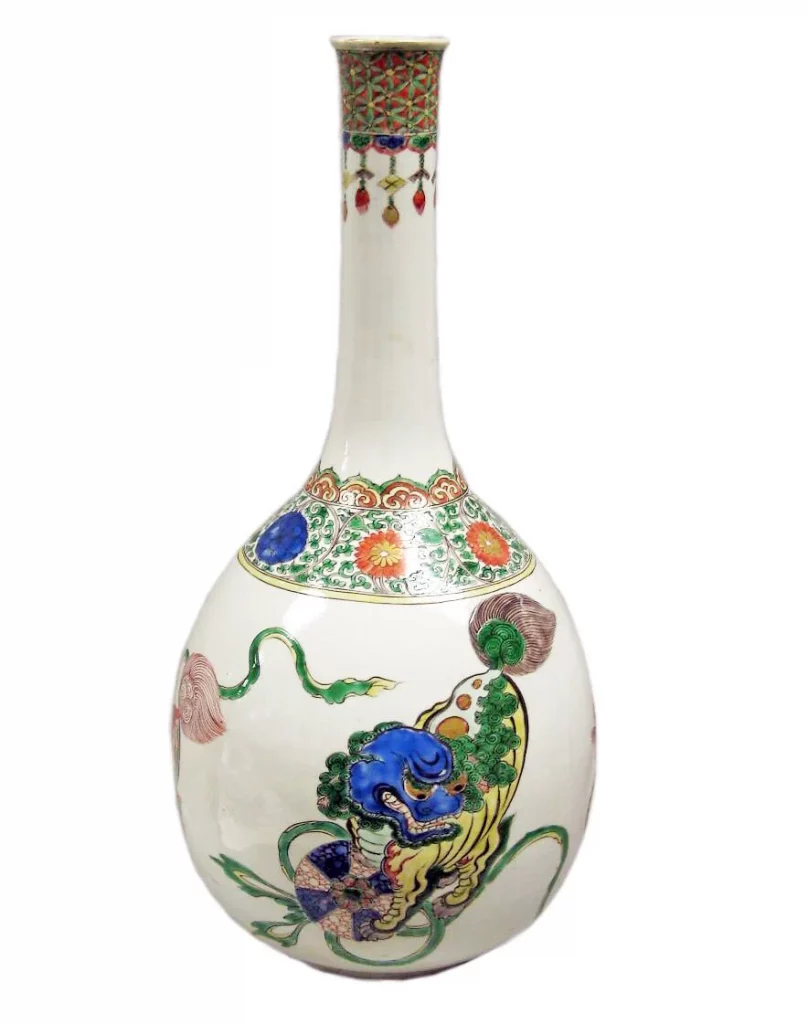
Over the past few decades, some Chinese ceramics have reached astronomical prices. For example, in 2021, a Chinese Imperial Revolving Vase sold for US$41.6m at Beijing Auction 1. And while you probably can’t really expect to find a $41+ million vase at a local estate sale, how can you tell if a Chinese vase you inherited from your late Aunt Bernice or are considering to purchase is valuable?
The following are some of the many factors to that determine the value of Chinese porcelain:
Age
The older the item, the more valuable it is likely to be. There are some exceptions to this rule, though. For example, a large, very well-crafted vase from the Republic Era, is still highly prized despite being relatively recent. The shape, color palette, decorative style, quality of painting, the glaze, the clay used, reign marks and other markings, and signs of aging are some of the many factors that can be used to determine the age of Chinese porcelains.
It is important to note that no single factor can definitively determine the age of a Chinese porcelain though. Only by considering many factors can make an accurate assessment of when the piece was made.
Shape

The shape of the vase can also be a factor in its value. Pieces with unusual or asymmetrical shapes, for example, are often more valuable than those with more common shapes. Also, some shapes have a long and rich history in Chinese culture, and this can also increase their value. For example, pieces that are based on traditional Chinese shapes, such as the lotus blossom or the dragon, are often more valuable than those with more modern shapes.
The skill and artistry with which a piece is shaped can also affect its value. Pieces that are beautifully proportioned and well-crafted are often more valuable than those that are more crudely made.
Decoration
The design and quality of execution are among the most important factors that affect the value of Chinese porcelain. A well-painted piece will be more sought-after by collectors and will therefore command a higher price. Also more elaborately decorated vases are generally more valuable than those with simple decoration.
Condition
The condition of a piece is extremely important. A vase that is in good condition will be worth significantly more than one that is damaged. In Chinese culture there is a strong emphasis on the importance of completeness and wholeness, and so many Chinese believe that damaged pieces are no longer “whole” or “complete.” This is reflected in the Chinese language, which has a number of words that mean “complete” or “whole.” For example, the word “quan” (全) means “complete” or “whole,” and it is often used to describe things that are in good condition or that are not damaged.
Of course, not all collectors – including Chinese collectors – feel this way about damages. Some may be willing to overlook minor damage, while others may even see them as a sign of authenticity.
Authenticity

Chinese porcelains are frequently reproduced, and this can make the difference between an item being worth $30,000 or $100! There is a long tradition of Chinese porcelains being reproduced. Some Chinese porcelains were intentionally made in imitation of past pieces to honor and celebrate past traditions. Others were made as replacements and still others as skeuomorphs in the trompe l’oeil tradition that developed in court arts of the Qing period. The concept of ‘fake’ in Chinese porcelain is therefore complex and its production is grounded in both commercial and connoisseurship practices. The practice is increasingly done today, though, to intentionally deceive buyers. Additionally, both the quality and quality of “fakes” have increased substantially in the past two decades.
In a recent video on Bidamount.com 2, Asian arts expert, Peter Combs commented on a rare Wanli Shou jar that recently kept showing up at auctions around the country. After closely looking at auction records, it was revealed that many copies of the same supposedly rare jar kept popping up at auction house around the country in 2013-2014. What was later discovered was that a factory in China began to mass produce very convincing copies of the jar around this time.
Despite the level of sophistication that has developed over the years, certain techniques are commonly used in forgeries. By familiarizing themselves with these techniques educated buyers can more easily identify many forgeries. For example, one exceptionally common technique is to darken the footring and base of a vase with “crud” to make it look old. Natural accumulations of dirt have different characteristics than applied “crud”. A trained (and sometimes even casual) observer can spot these under close inspection.
Another example is that many forgers try to imitate “soft flaws” by using pebbles or sand paper to softly scrape or scratch the porcelain surface. However, it’s very hard to produce different shaped dots, scars, bruises or scratches. Faked “flaws” normally have similar intensity, depth, length and direction and look very unnatural.

Here are some basic tips for spotting fake Chinese porcelain:
-
- Look for signs of modern materials. Fake porcelain often contains modern materials, such as plastic or glass, that were not available in the past.
-
- Check the glaze. The glaze on a fake porcelain piece may be too thick or too uniform. It may also have a different color or texture than the glaze on an original piece.
-
- Compare the design to known examples. If you are familiar with Chinese porcelain, you can compare the design of the piece you are considering to known examples. Fakes often have incorrect or copied designs.
The best way to spot forgeries is to closely study both authentic pieces and forgeries. You can do this by reading about them 3, visiting museums, and handling (yes, touch if permitted) many, many examples. Buy pieces with a known provenance. Invoices and auction results from well-known and respected antique dealers and auction houses are also useful. If you are not sure whether a piece of Chinese porcelain is real, it is best to buy from a reputable dealer who can guarantee the authenticity of the piece.
Market Conditions
Market conditions also affect the value of Chinese porcelains. Demand for Chinese ceramics, fueled by the growing number of affluent Chinese buyers over the past 20 or so years, drove up prices to unsustainable levels. A couple of years ago a combination of political and economic developments in China, as well as a growing wariness around counterfeits, resulted in a slight cooling-off of the market. This has particularly hit the lower and middle ranges of the marks; high end pieces can still fetch record or near-record prices.
Identifying Chinese porcelain is a very specialist skill set. Multiple factors must be reviewed with an expert eye. And keep in mind that even experts can be fooled. A joke Larry and I often make is you can get two experts in Chinese ceramics in a room and get three different opinions. Nevertheless, while it can take decades of experience to conclusively authenticate and value some very rare pieces, it is possible for even casual collectors to learn to identify and accurately value more common pieces.
Once I have identified the piece, how do I determine its value?
Once you have identified the item’s age and many of the other characteristics mentioned above you can gain an accurate feel for the current market value by comparing the piece to similar pieces that have been sold at auction. You can find information about auction sales online or in auction catalogs. In addition to sales records often found on the websites of the major auction houses, such as Christies, Sotheby’s and Bonhams, another good online resource is LiveAuctioneers. Online marketplaces can also be useful resources,b ut be sure you’re looking at a record of what the item actually sold for and not just the asking price. Also remember that many items you find on some online marketplaces and secondary auction houses might not be authentic, and so you will need to look closely at detailed photos and descriptions to confirm their authenticity.
If you are unsure of the value of an item, it is best to consult with an expert. Sometimes, you can submit photos and other information through an online form to get expert feedback. Bidamount, for example, offers a highly reliable – and reasonably priced – service for determining the authenticity and value of a wide range of Chinese and Japanese objects. One challenge with such a service is that the expert is limited by their inability to see and touch the item in person.
An appraiser, on the other hand, can examine the item, determine authenticity, and age, and provide you with an estimate of its value by inspecting the item in person. Because of the wide variety of Chinese ceramics, many appraisers specialize in work from a specific period or style. If the item is particularly valuable, you might want to talk to an expert in the style you’re curious about to get the most accurate information.
And so, while you are unlikely going to uncover a Chinese Imperial Revolving Vase worth $41.6m in your grandmother’s attic (unless your grandmother was the Empress Dowager Cixi), you might just find a lovely late Qing wine pot worth $500. Or spot that sleeper at the local auction house and pay pennies on what it’s really worth because you knew what it was and what it was worth. That’s a dream of most of us collectors!
_____
1https://en.thevalue.com/articles/poly-beijing-qianlong-revolving-vase-auction-record-result
2 Weekly Chinese and Asian Art Auction News, A Wanli Jar Conundrum June 23, 2023
3 Serious collectors of Chinese porcelains should invest in at least a few good books; however, you can also find archives of some excellent reference books on a website called Bidamount.
Additional Resources
-
- Bidamount.com – Offers a wide range of resources, including articles, video, and a treasure trove of library resources on Asian art. Most of these resources are available free of charge.
| Bear & Raven Antiques offers a wide variety of high-quality vintage and antique Chinese, Japanese and Victorian pottery, porcelain and silver plate, bookends, as well as an eclectic selection of other vintage collectibles.We also offer a wide range of appraisal services including formal and informal appraisals of personal property, estate clearance, advisory, consulting and brokerage. We specialize in Chinese, Japanese and other Asian antiques, but also offer expertise with a wide range of personal property. We primarily serve appraisal clients in Tucson, Phoenix and Southern Arizona, but are available to travel throughout the United States. |







